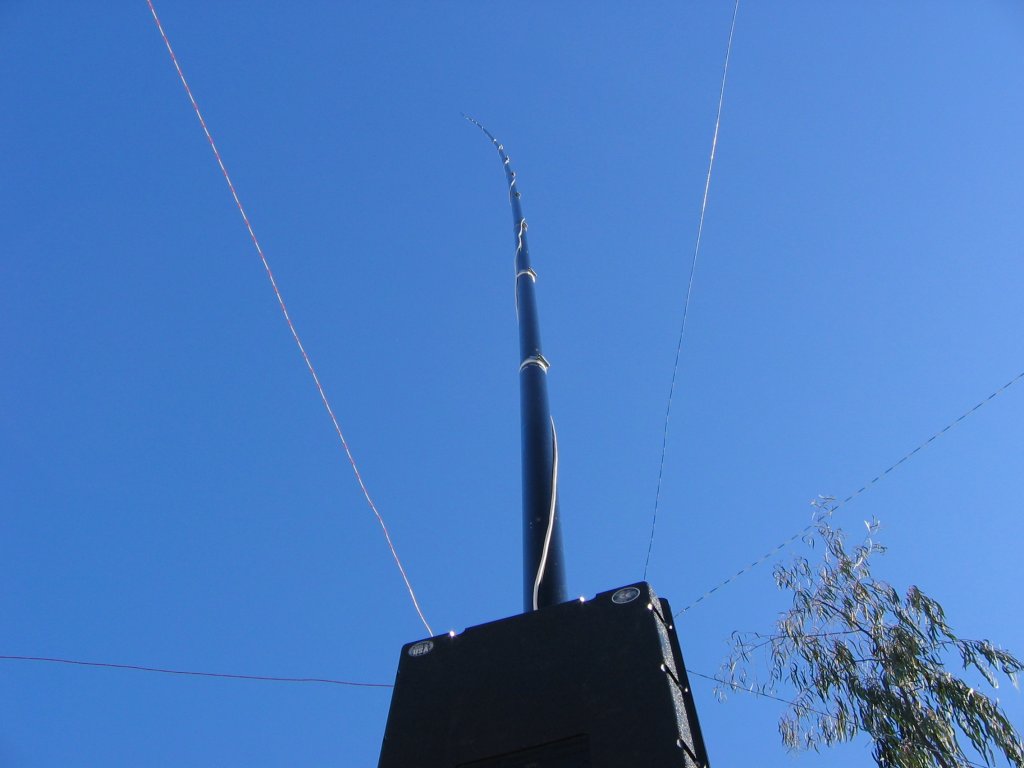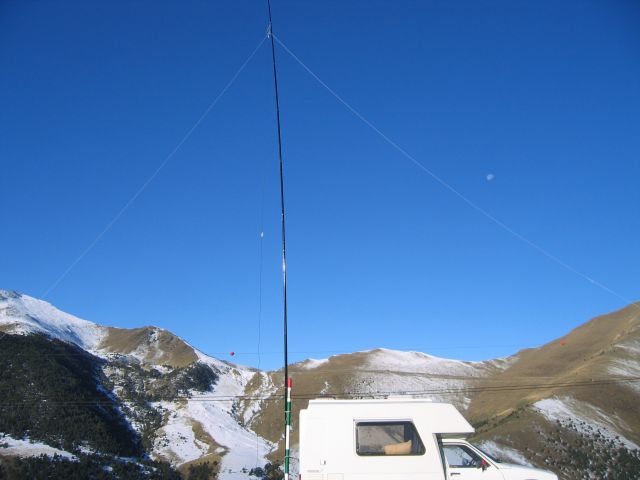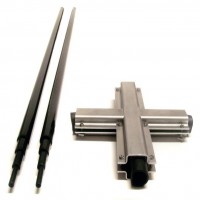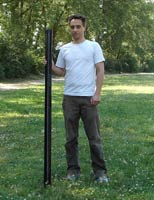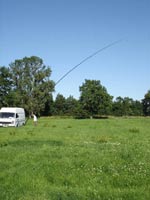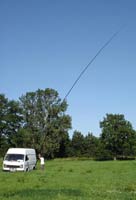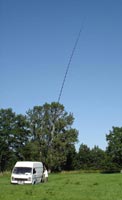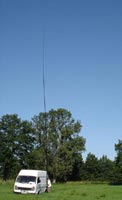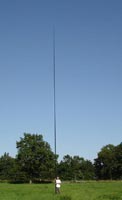THE G4ZU....SPIDER BEAM......SKYPPER
This 3 elements wire Yagi comes along in a great variety of names. On the 11 meter we call it the Skypper due to the manufacturer Alex 1SD019
On Ham bands we call it the Spider beam or G4ZU.
What ever the name is its principle remains the same. It is a full-size 3 elements Yagi with the Director and Reflector bend towards the radiating element.
With this comes a small size Yagi with Gain 7,3 dBI and Front to Back in the order of 30 dB
It is easy to build, with the materials in front of me I had the first SWR test within an hour. And provided a great match within the 700 Khz bandwidth.
This is one antenna i will not get ride of...always handy for DX-expedition, Holiday or Back-up for home
The materials you need:
4 X fiberglass poles
Teflon wire about 5 meters
Electrical wire 15 meter
2 X U bolt
1 meter aluminum tube (80cm)
small aluminum plate about 5 centimeters long 2 centimeters wide
The fiberglass poles :
I used are fishermen tubes, each of a length of 4 meter lengths. You will need only about 2,5 meter of the fishing rod but the lower part of it is stronger therefore the antenna will stand through have wind. It is easy possible to make the framework from other materials, I have seen models made from bamboo as well.
The Teflon wire :
used, originally wash line Teflon...4 mm, but any NON-guiding wire is usable (perhaps from sailing boats that's extra strong)
The Electrical wire:
Any plain black and red 12 volt wire, or other form of electric guiding wire is good..(example: loud speaker wire )
U-bolts :
The U bolts we find on any old 27 mhz antenna are fine. You can also buy them at the local hardware store. Just make sure it fits the mast the beam is supposed to go on.
Aluminum tube:
The 1 meter aluminum tube has either fit INTO or AROUND the fiberglass poles in such a way that there is not to much friction.
Cut the aluminum tube in 2 pieces of 50 centimeter or 40 centimeter...no that critical.
- drill 2 holes close to the center of each tube. The sizes need to be large enough for the U-bolts ( see picture below)
MAKING OF THE FRAMEWORK:
The first thing you should do now is put the U bolts though the aluminum tubes and connect the aluminum tubes to a mast. Make sure you have about 30 centimeter of mast left above these aluminum tubes.
Connect the tubes above each other with 90 degrees difference. as shown in the picture
Connect the 4 fishing rods to each open end of the aluminum tube. Now looked from above you should see a cross.
MAKING OF THE ELEMENTS.:
Cut the electrical wires in pieces of : 5,25 meters (the reflector)
5,04 meters (the radiator)
4,84 meters (the director)
Take the reflector and put in the center of the reflector a little tape. This will help you determine the center of the reflector later.
The same counts for the director.
Take the radiator and cut it in half. You now have two pieces of 2,52 meter. uncover the sealing from both wires at one side for about half a centimeter.
Solder the uncovered electrical wires. Each independent. And enter them in the block-connector. This is your access for the coax. There are many more ways to attach the coax cable on it but this is about the simplest way.
What I did was take a small aluminum plate drill holes through it and used that for braking the tension.
PUTTING IT TOGETHER:
Attach the radiator on the mast about 30 centimeters above the aluminum cross.
Connect the Teflon wire (about 2x 50 centimeter) to the radiating dipole at both ends the knobs you can use for that are as follows:
This knob will tighten itself when tension is brought on it.
Attach the Teflon wires to the fishing rods they should be in a bowl position now.
Attach the other fishing rods...
Bend the fishing rods upwards and measure 2,5 meters from the Block-Connector. Put a tape around both fishing rods at that point. (this will be approx 2,6 meter)
Connect the Reflector (tape on tape) on a fishing rod. And connect the Director on a fishing rod. (again tape to tape)
You could connect them with either wire or T-reps.
Bring the Teflon wires towards the fishing rod. of the radiator and attach them at the same point where u attached the radiator.
Make some final small adjustments that a nice square is produced.
For long lasting results you could improve the coax connection, get rid of the T-reps. and a paint on those fishing rods would not be misplaced.
The cost I made for this project was in the order of 40 euro's I believe this could have been around 25...30 euro's simply because I bought fishing rods that were 4 meters long but 3 meters can do the trick as well.
For the first time building you will probably need about 3..4 hrs to make everything right, that's not bad for an antenna that will work as good as any 3 elements yagi!
Any Questions please send an e-mail!
Read more...
Saturday, December 31, 2011
12m SpiderBeam Vertical Pole Antenna
12m SpiderBeam Vertical Pole Antenna
I’ve really been impressed this weekend over the quality of 160m SSB operators who I found were courtious, patient and keen to accept my call. I’ve done single-band entries before on 40m where the tight frequency allocation and numbers of operators mean that there’s a pretty agressive tension in the air - not so 160m. There seemed to be space enough for the big runners to hold a frequency and enough of them to allow the casual Search and Pounce operator to have a couple of hours fun from time to time.
Regular readers of this site know that although I’m a keen contest operator, I love building and testing antennas. This weekend allowed me to build something a little different to squeeze in a 160m vertical into my back garden where I only have 10m x 15m to play with (in old money, that’s only 30 x 50 feet).
Pictures tell a thousand words so I won’t go into the heavy details other than I used up the full 12m SpiderBeam pole and put up 8 radials ranging in size from 6 meters through to 12 meters (telephone wire, spare from an old reel). The Feedpoint was 2 meters off the deck and the radials were parallel to the ground. I fed it at the feedpoint with an SG-230 powered by a car battery housed in the shed. 30 meters of low-loss, double-shielded Westflex coax fed the tuner.
My only trouble was that after a few hours, the pole started to telescope into itself with the strong wind which required me to take it all down and hose-clamp (jubilee clip) each section after using liberal amounts of plastic tape so that I wouldn’t damage the fibreglass. SpiderBeam do a clamp-set with small rubber shields and if you are thinking of getting one of these, do buy the little clamp set, it’ll make your life easier. Even then, one of the sections moved a few inches in the night. It’s settled now - but you can see the vertical telephone wire that I used as the antenna has become slightly loose.
Results were quite encouraging and with only three or four ventures onto 160, fitting in dinner, bedtimes and some family TV, I scored 51 QSOs with the USA being the biggest potential DX. I didn’t work them though. My footprint covered the near Atlantic islands (Madeira etc), North Africa through East Mediteranean and up around European Russia and Finland. I genuinley didn’t believe that such a small antenna would work that well particularly at only 100w. I think getting all the RF into the antenna instead of wasting power heating coax may be the key here - and it’s the SG-230 that takes the blame for this :)
Final relaxed score was 51 QSOs, 24 Countries for 6,144 points.
More photos here: http://www.m0mcx.co.uk/gallery/index.php?/category/55
REF Contest: Not content with one contest this weekend, I also entered the REF contest. Conditions were terrible though. I’ve had much bigger runs into France on 40m but not this weekend. It kept me out of trouble but certainly nothing to write home about. 20m was off the score card because I could rarely find any propagation into France on 20m - the same on the higher bands too.
It did give me a chance to use the vertical though for general purpose DX and occassional tests with James (M3YOM) who had also put up a similar antenna this weekend - also using an SG-230! For me, some mixed results although the vertical normally won the competition barring 80m where the higher levels of radiation inter-UK suited the full-wave NVIS loop better.
I’m left with one question: Why did the vertical work on 160m locally - but not on 80m locally where the loop was required? There’s some propagation going on here that I don’t understand. More experiments are required.
Overall though, a great experiement though.
Cheers and beers.
Read more...
I’ve really been impressed this weekend over the quality of 160m SSB operators who I found were courtious, patient and keen to accept my call. I’ve done single-band entries before on 40m where the tight frequency allocation and numbers of operators mean that there’s a pretty agressive tension in the air - not so 160m. There seemed to be space enough for the big runners to hold a frequency and enough of them to allow the casual Search and Pounce operator to have a couple of hours fun from time to time.
Regular readers of this site know that although I’m a keen contest operator, I love building and testing antennas. This weekend allowed me to build something a little different to squeeze in a 160m vertical into my back garden where I only have 10m x 15m to play with (in old money, that’s only 30 x 50 feet).
Pictures tell a thousand words so I won’t go into the heavy details other than I used up the full 12m SpiderBeam pole and put up 8 radials ranging in size from 6 meters through to 12 meters (telephone wire, spare from an old reel). The Feedpoint was 2 meters off the deck and the radials were parallel to the ground. I fed it at the feedpoint with an SG-230 powered by a car battery housed in the shed. 30 meters of low-loss, double-shielded Westflex coax fed the tuner.
My only trouble was that after a few hours, the pole started to telescope into itself with the strong wind which required me to take it all down and hose-clamp (jubilee clip) each section after using liberal amounts of plastic tape so that I wouldn’t damage the fibreglass. SpiderBeam do a clamp-set with small rubber shields and if you are thinking of getting one of these, do buy the little clamp set, it’ll make your life easier. Even then, one of the sections moved a few inches in the night. It’s settled now - but you can see the vertical telephone wire that I used as the antenna has become slightly loose.
Results were quite encouraging and with only three or four ventures onto 160, fitting in dinner, bedtimes and some family TV, I scored 51 QSOs with the USA being the biggest potential DX. I didn’t work them though. My footprint covered the near Atlantic islands (Madeira etc), North Africa through East Mediteranean and up around European Russia and Finland. I genuinley didn’t believe that such a small antenna would work that well particularly at only 100w. I think getting all the RF into the antenna instead of wasting power heating coax may be the key here - and it’s the SG-230 that takes the blame for this :)
Final relaxed score was 51 QSOs, 24 Countries for 6,144 points.
More photos here: http://www.m0mcx.co.uk/gallery/index.php?/category/55
REF Contest: Not content with one contest this weekend, I also entered the REF contest. Conditions were terrible though. I’ve had much bigger runs into France on 40m but not this weekend. It kept me out of trouble but certainly nothing to write home about. 20m was off the score card because I could rarely find any propagation into France on 20m - the same on the higher bands too.
It did give me a chance to use the vertical though for general purpose DX and occassional tests with James (M3YOM) who had also put up a similar antenna this weekend - also using an SG-230! For me, some mixed results although the vertical normally won the competition barring 80m where the higher levels of radiation inter-UK suited the full-wave NVIS loop better.
I’m left with one question: Why did the vertical work on 160m locally - but not on 80m locally where the loop was required? There’s some propagation going on here that I don’t understand. More experiments are required.
Overall though, a great experiement though.
Cheers and beers.
Read more...
Fun and Games with the Spiderbeam 18 Meter Pole
Fun and Games with the Spiderbeam 18 Meter Pole
Read more...
For the past 20 years I have been using fishing poles of various lengths to support wire antennas on “DXpeditions” to my favourite operating site in Andorra, Col de Botella, near the Pal Ski Resort at an altitude of 2200 meters.
When I heard about DF4SA’s massive 18 meter (60 foot) fiberglass pole, I was anxious to try it. The 2007 CQWW Phone Contest provided me with an opportunity to experiment with several different antenna configurations supported by the pole and to do a lot of testing in a couple of days.
The plan was to drive up to the Col on Friday afternoon and spend the entire weekend in my little Romahome Camper. Things got off to a slow start when it snowed on Thursday night, making it impossible to reach my destination. By Saturday afternoon, most of the snow had melted on the road, and I was able to get there.
There are 2 ways to put the pole up and down. You can stretch it out to full length, anchor the base against a car tire or other immoveable object, and walk it up, or you can fix the base section to a vertical object (such as the steel poles marking the edge of the road) and extend the pole section by section, locking the clamps as you go.
Both methods worked fine. I found that it was easier to keep the wires untangled and to make changes if I used the section by section method. Especially when working in the dark in sub-zero temperatures. Just remember not to loosen the clamp on the smallest section, or you will have to tilt the pole to get the top back out again.
The plan was to put up a one wavelength square loop for 20 meters in the diamond configuration, and a delta loop for 40 meters with a common feedpoint. In theory, the 20 meter loop would be a 2 wavelength loop on 10 meters and the 40 meter antenna would be a 3 wavelength antenna on 15 meters, providing 4 bands on one feedline when matched with a 4:1 balun to 52 ohm coax.
I put up the 20 meter loop first, using two 4 meter poles provided by Con as spreaders. 18 guage insulated wire was used for the elements. 2 mm nylon cord was used to pull the elements into shape and act as guys in 2 directions.
The location I use is limited in that on one side there is a road, and on the other side there is a precipitous drop off. That means that I can't use guys to support the mast, except in 2 dimensions. The antenna has to be self-supporting.
It was possible to mount the spreaders 12 meters up and raise the mast, but the slightest wind would cause the top to bend. In a flat field, guys, made with 2mm nylon cord, supporting the mast in 4 directions would solve this problem.
In my situation, it was better to lower the spreader and give up a little height. I opted to make the top of the antenna 13.6 meters high, and ignore the top 3 sections of the mast.
This configuration proved stable and was easy to raise and lower to make length adjustments on the elements to tune the antenna. As expected, once tuned, the SWR was 1:1 in the middle of the 20 meter band and 2:1 in the 10 meter band. Bandwidth was adequate for a phone contest. Turning the antenna showed a strong front-to-side ratio, especially on 10 meters.
Masonry plugs and small screw eyes are inserted into the ends of the spreaders. The wires run easily through them.
After working a few hundred stations on 20 and 10 meters, I decided to create the 40 meter antenna before it got dark. I measured out 43.4 meters of wire and used the same point, 14 meters high, to support a delta loop. The feed was to the same balun.
As expected, the SWR was perfect on 40 meters and OK on 15. I did some operating on 15 meters, and then operated 20 meters until the band closed. On 20 the SWR was still 1:1 in the center of the band, but the bandwidth was much less with the extra loop in place.
After a pleasant dinner in the camper, and several glasses of red wine, I decided to give 40 a try. This is a pretty casual way to operate a contest. The object is maximum enjoyment, not maximum score.
The SWR on 40 was 1:1 and the radio was putting out full power, but nobody could hear me. It was very frustrating. 60 over 9 Europeans would repeat their CQ when I called. I really don't know why the antenna didn't work. This is what happens when you design antennas off the top of your head instead of using modelling software.
I don't know if it was too much wine or the long day raising and lowering the antenna, but I became very sleepy and not very motivated. I crawled under the duvet and dreamed of being rare DX so everyone would hear me, no matter how weak I was. Oh, I am rare DX. I guess even when you are rare, you still have to radiate some RF to be heard.
Long before dawn, I woke up and decided that I would have to change the antenna. The easiest thing to do would be to cut a simple 40 meter dipole and make an inverted-Vee. With my LED headlamp in place, I ventured into the sub-zero darkness and lowered the mast. It was not difficult at all to remove the two loops and put up a 40 meter dipole. A quick trim at the ends and resonance was found. By 6:15, I was on the air. I worked P40A, PJ2E and V26B in quick succession with one call each. I guess this one works. Amazingly, I was even able to make some contacts on 15 meters before daylight in Andorra.
Spiderbeam Pole supporting a 40 meter Inverted Vee
When 40 meters died out, and the sun was warming the air, I decided it was time to get back on 20 meters. Down came the mast again.
It occurred to me that it really wasn't necessary to use the fiberglass spreader, and that the diamond shape could be maintained by pulling the corners out with cord to anchor points on the adjacent roadside poles, about 20 meters away.
Using the same loop as yesterday, I raised the mast again. The resulting diamond shape was not much different than before. Without the weight of the spreader, it would be easy to raise the top of the loop to at least 15 meters, and probably higher without guy wires in the orthogonal directions.
Without the 40 meter loop in parallel, the bandwidth on 20 was much greater. This was nice. But on 10 meters the SWR was higher than before. Fortunately, my Icom IC-7000 didn't seem to mind and I was able to operate 10 meters anyway. By the end of the afternoon, I had made 486 contacts on this dead band at the bottom of the sunspot cycle running 50 watts to a wire antenna.
Once again, in the late afternoon, I got out the wire cutters and snipped some wires. I made up an 80 meter dipole to use once it got dark.
After dinner, in total darkness, I lowered the mast and replaced the 20 meter loop with the new 80 meter dipole and the 40 meter dipole from this morning. A few times up and down and I was able to achieve resonance on 80 meters and bang off a couple of hundred contacts.
But when I switched to 40 meters, the proximity of the antenna to my rig caused RF feedback to enter the control head and cause it to shut down. My fiberglass camper doesn't provide the faraday shield of a steel automobile.
Oh well, I ventured back into the cold night to take down the 80 meter dipole and leave the 40 meter inverted Vee back where it was this morning. That worked fine, and I was able to make another 100 or so contacts before quitting for the night.
In summary, I was very happy with the Spiderbeam mast. It was easy to assemble and could be raised and lowered with little effort. I must have put it up and down 20 times on the weekend. There are certainly lots of portable or even permanent antennas that could be made from simple verticals to complicated loop arrays using this handy pole.
I have always been curious as to how the resonant frequency of a dipole changes as you reduce the angle at the apex of an inverted-Vee antenna. Having some time on Monday morning to experiment, and with the handy SWR analysis display of the IC-7000, I decided to play with the antenna before bringing it down.
By moving the ends of the antenna, easily done as they were tied to stone weights, I could change the resonant frequency from 6850 KHz to 7150 KHz without adjusting the feed point or the wire length. The sharper the angle, the higher the frequency.
Of course, the pattern changes as well, but it is interesting information, and it means you can tweak the SWR a bit without a lot of trouble when putting up a portable antenna.
Spiderbeam Mast Section Heights
1 1.7 m
2 3.1 m
3 4.6 m
4 6.1 m
5 7.5 m
6 9.1 m
7 10.6 m
8 12.1 m
9 13.6 m
10 15.1 m
11 16.7 m
12 18.2 m
Read more...
Spreader Kit for 1ele Quad
| Spreader Kit for 1ele Quad |
The Quad Spreader Kit has been designed for building portable 1el Quad loops mounted to our 12m Spiderbeam fiberglass pole. The Kit includes all needed parts, i.e. a metal center joint (with rubber padding) and two telescopic fiberglass tubes (4m long). The metal center joint has very small packaging dimensions, as it can be disassembled completely. The kit is well suited for building a 1el Quad for 20m and all bands above. The metal center joint is mounted to our 12m fiberglass pole at a height of 8m, letting the remaining upper 4m of the 12m pole protrude above the center joint. The two 4m long telescopic tubes are inserted into the left and right leg of the metal center joint. These two 4m long tubes are absolutely identical to the upper 4m part of the Spiderbeam 12m fiberglass pole. Thus a quadratic cross with an 8m long diagonal is formed, enabling you to string quad loops of up to 22m circumference. The loops can be fed at the lower corner (i.e. approx 4-5m above ground). The resulting effective height of the loop is 8m above ground, ensuring a good radiation pattern. Download assembly instructions here: quadspreader_assemblyguide_english.pdf | ||||||||||||||||
Read more...
Spiderbeam HD 12m fiberglass pole
| Spiderbeam HD 12m fiberglass pole |
Spiderbeam Heavy Duty fiberglass poles are perfect for building all kinds of wire antennas. A single person can easily put them up within a few minutes. Especially developed to make our portable equipment even more rugged and durable! These are extremely strong poles, with a much greater wall thickness (up to 2mm!) than the usual "fishing rod" types. A special reinforcing winding technique - several layers of fiberglass are wound in alternating direction (criss/cross winding) - provides greatly increased lateral and linear strength. Stronger joints are achieved by a much larger overlap between the individual tube segments than usual. Spiderbeam 12m Heavy Duty poles are very well suited for building 40/80/160m wire GP or inverted L antennas. (Lee W9OY has built a beautiful 80/40m vertical using our poles:http://w9oy.painloss.com/SSvert/SSvert.htm). They can also easily support temporary lightweight 1 Element Quad or Delta loops for 20-10m, and dipoles for all bands, especially when used with open wire feedline. (Most baluns would be somewhat heavy). 4-6 poles could be used to build lightweight beams for 40 or 80m. Even the top segment is 8mm in diameter (and 1.4mm wall thickness), so the poles can be used to their full 12m length - unlike other poles where the top segment is very thin as a whip. During our tests we were able to put 80m inv vee dipoles (made from 1mm diameter enameled copper wire (AWG 18) and open wire feedline) right at the top of the 12m pole.. No way you can do this with a regular "fishing rod"! At 9-10m height, the poles can easily support small VHF / UHF yagis. The best (and cheapest) wire to use for building such wire antennas (verticals, loops, dipoles etc.) is AWG 18 (= 1mm diameter) enameled copper wire or similar. Thin fishing monofilament (1mm diameter) or similar rope is very suitable for guy lines. The first prototypes were tested Nov/Dec 2004 during 120km/h winds at the North Sea coast and performed just great! Since then, well over 3000 poles have been installed worldwide. Get yours today and enjoy outdoor radio with a professional heavy duty pole.. | |||||||||||||||||||
Read more...
Spiderbeam 26m fiberglass pole
| Spiderbeam 26m fiberglass pole |
We are excited to present the newest and tallest addition to our family of high quality fiberglass masts - the incredible 26m pole! This pole is built very similar to our well proven 12m and 18m fiberglass poles, and carefully designed to maintain low weight and perfect balance. During extensive testing for several months on the Baltic sea coast the prototype has weathered all storms without any problems and we feel ready offering this product to the market. Click the photo below for a fullsize view of the pole installed on the test site. 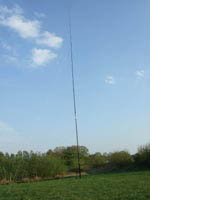
This pole puts serious 160m activities into a new perspective! Just add a few top hat wires and enjoy operating with a fullsize 160m vertical that can be put up within less than an hour. This pole opens the door to building portable 160m 4-square arrays and other serious low band fun like vertikal dipole arrays on 40m, or a 20/15/10m 1el quad at 20m height above ground, etc. Our vertical junction box / radial plate makes building wire verticals very easy. The following VIDEO shows how to install the 26m pole with two persons ... with some experience it is also possible for one person alone: For those who can not see the above video, here is a brief description:
The pole comes complete with a set of 14 rubber padded stainless steel clamps and 3 guy rings made from strong belts, for guying the mast above the 4th segment, above the 7th segment, and above the 11th segment. The best suitable rope for the lower two guy lines (above segment nr. 4 and 7) is our 2mm Kevlar rope. For the upper guy line (above segment nr. 11), our thin 1mm Kevlar rope is suited best. | |||||||||||||||||||
Read more...
Spiderbeam 18m fiberglass pole
| Spiderbeam 18m fiberglass pole |
Imagine building a quick portable 80m 4-square array that you can put up within less than one hour... A single person can easily "walk up" the pole within a few minutes (click pictures to enlarge):
Spiderbeam 18m (60ft) fiberglass poles are built very similar to our well proven 12m HD fiberglass poles, yet carefully designed to maintain low weight and perfect balance. The pole starts out very rugged at the bottom (73mm diameter / 2mm wall thickness) and still has 40mm diameter / 1.5mm wall thickness at 10m height! The upper sections are slim and light (1mm wall thickness), preventing the pole from becoming top-heavy and keeping it perfectly balanced. A special reinforcing winding technique - several layers of fiberglass are wound in alternating direction (criss/cross winding) - provides greatly increased lateral and linear strength These poles are perfect for building all kinds of wire antennas, especially 80/160m wire GP or inverted L antennas. They can also easily support temporary lightweight 1 Element Quad or Delta loops for 40-10m, and dipoles for all bands, especially when used with open wire feedline. (Most baluns would be somewhat heavy). 4-6 poles could be used to build lightweight beams for 40 or 80m (...who is going to build one for 160? :-)). The best (and cheapest) wire to use for building such wire antennas (verticals, loops, dipoles etc.) is AWG 18 (= 1mm diameter) enameled copper wire or similar. Pole installation: One person can easily "walk up" the pole by pressing the bottom against a rock, tree, car or ground anchor, or having a second person hold it. Once the pole is in vertical position, it can easily be moved around. Fix the bottom to a ground anchor and attach guy lines at 2 levels. Thin fishing monofilament (1mm diameter) or 2mm Kevlar rope is very suitable for guy lines. To complete the installation we strongly recommend using our rubber padded stainless steel clamps to safely secure the telescoping elements from slipping down. For a pole of this large size, clamps are a better solution than using tape only.
Get your 18m pole today and enjoy successfully putting out a big low-band signal within just a few minutes... | |||||||||||||||||||||||||||||
Read more...
Friday, December 30, 2011
IOTA 50th ANNIVERSARY MARATHON
INTRODUCTION
IOTA 50th ANNIVERSARY MARATHON
THE YEAR 2014 marks the 50th anniversary of the launch of the Islands On The Air (IOTA) Programme by British SWL Geoff Watts, BRS-3129. To celebrate the occasion, the RSGB IOTA Manager and Committee announce an exciting activity period in which all licensed amateurs world-wide are invited to participate.
For a two-year period during 2012 and 2013, IOTA chasers are encouraged to contact as many different IOTA groups as possible, and IOTA activators to play their part by operating from as many groups as possible, with special emphasis on the less-frequently activated ones. The points system adopted rewards 'Activators' with higher scores for activating the rarer IOTA groups. Certi ficates and awards will be available to both 'Chasers' and 'Activators' to reflect attainment of graduated bands of performance.
The challenge provides a level playing field for everyone, whether they are complete newcomers to IOTA or are holders of the prestigious IOTA 1000 Islands Trophy, because everyone starts with a clean slate on 1 January 2012. Furthermore, the long time scale of the challenge means that, should a participant miss a DXpedition to an island, there is a chance that he / she may be able to pick it up at a later date if the group is activated again during the 50th Anniversary Marathon period or, failing that, to replace it with another counter from the 1100 activated groups.
Prizes will be awarded to the highest-scoring individuals in both the ‘Chasers’ and ‘Activators’ sections and these will, if circumstances allow, be presented during the IOTA 50th Anniversary celebrations at the RSGB Convention in 2014. Certificates will be available to other participants who reach the specified grade levels.
RULES
GENERAL
1. The IOTA 50th Anniversary Marathon takes place from 0000UTC 1 January 2012 until 2359UTC 31 December 2013.
2. Its purpose is to promote the IOTA Programme during the lead-up period to the Anniversary and to provide enjoyment and fun to participants by encouraging greater activity from IOTA island groups and in particular the less-frequently activated ones.
3. There are two sections: ‘IOTA Chasers’ and ‘IOTA Activators’. Participants may enter both the ‘IOTA Chasers’ and ‘IOTA Activators’ sections.
4. Participants must be licensed radio amateurs and will be required to certify that they have followed licensing conditions applying in the country of operation.
5. Participants may use any band and any mode for which they are licensed.
6. Participants are urged to follow best operating practice as published in the amateur press. Instances of bad behaviour may result in disqualification.
7. All participants, and in particular IOTA ‘Activators’, are strongly encouraged to upload their logs to Club Log (http://www.clublog.org), a free web-based tool for producing league tables, log search services etc. The IOTA Committee may in cases of doubt use Club Log as a tool to confirm the accuracy of applicants’ logs, so uploading to Club Log could in certain circumstances remove that doubt and secure the claimed points.
8. As the IOTA 50th Anniversary Marathon is a separate event from the normal RSGB IOTA Programme, applicants must still obtain QSL cards (or obtain confirmations during the RSGB IOTA Contest in July), in the normal way, in order to count island groups contacted during the 50th Anniversary Marathon period towards their regular IOTA score.
9. The decisions of the RSGB IOTA Committee are final.
‘IOTA CHASERS’ MARATHON
1. There will be two categories of entry, single-operator and multi-operator / club. In the single-operator category all contacts must be made personally by the applicant using a call-sign issued personally to him / her by the licensing authority. In neither category is a combination of callsigns allowed, although mobile and portable suffixes e.g. /M, /P or /a province designator will be accepted.
2. A two-way contact with a qualifying island in a numbered IOTA group attracts one point. The same group may be contacted up to three times, each on a different band, for up to three points.
3. All contacts claimed must be made from within the same DXCC entity.
4. Except where varied here, participants should regard the rules for the Standard and Club Categories of Application in the 2011 IOTA Directory as applying.
5. QSLs are not required, but in the event of a dispute or doubt about a QSO, the RSGB IOTA Committee may take whatever measures they consider appropriate to resolve the issue, including asking the island operator to check his / her log. Uniques or near- uniques will be subject to special scrutiny.
6. Operators participating either as a single operator DXpedition or as part of a multi-operator DXpedition may claim 3 points credit towards their score in the ‘IOTA Chasers’ Marathon for each island group that they activate themselves, so long as they personally make a minimum of 100 contacts during the operation. However, in accordance with Rules 1 and 3 above, as an 'IOTA Chaser' the y may only claim credit for other island groups worked as an 'Island Activator' when they are operating from their own DXCC country, using their normal personal call-sign and are not part of a multi-operator event.
‘IOTA ACTIVATORS’ MARATHON
1. There will be two categories of entry, single-operator and multi-operator / club. In the single-operator category all contacts must be made personally by the applicant using a call-sign issued personally to him / her by the licensing authority. In neither category is a combination of call-signs allowed, although mobile and portable suffixes e.g. /M, /P or /a province designator will be accepted.
2. Points are gained for activating a qualifying island in a numbered IOTA group, as follows:
For activating an 'All-Time' new IOTA 50 points
For activating an IOTA claimed by fewer than 15% of IOTA participants 25 points
For activating an IOTA claimed by 15 - 30% of IOTA participants 20 points
For activating an IOTA claimed by 30 - 45% of IOTA participants 10 points
For activating an IOTA claimed by 45 - 60% of IOTA participants 5 points
For activating an IOTA claimed by 60 - 75% of IOTA participants 2 points
For activating an IOTA claimed by more than 75% of IOTA participants 1 point
The number of points associated with each island group will be determined by the percentage of active IOTA participants who have claimed that group as of 1 December 2011. The list of IOTA groups, with the number of points to be gained for activating each, will be published on the IOTA web-site at http://www.rsgbiota.org during December 2011. The number of points associated with each IOTA group will remain the same throughout the entire period of the 50th Anniversary Marathon, regardless of how frequently a ny group is activated after 1 December 2011.
3. It is not within the spirit of the 50th Anniversary Marathon for ‘Activators’ to seek to gain points for one or more very short mini - operations resulting in few QSOs. To prevent this happening the IOTA Committee has decided that in order to qualify for point s all activations must be longer than 10 hours (from the time the first QSO is made until the time of the last QSO), and at least 100 QSOs must be made.
4. Impact of activity: Multi-operator / multi-station and longer duration DXpeditions are particularly encouraged in order to give more
‘Chasers’ the opportunity to make a contact. IOTA ‘Activators’ will therefore be rewarded with ‘bonus points’ as follows for the number of contacts made:
Activity resulting in fewer than 1000 QSOs 0 bonus points Activity resulting in 1001 to 2000 QSOs 2 bonus points Activity resulting in 2001 to 3000 QSOs 4 bonus points Activity resulting in 3001 to 4000 QSOs 6 bonus points Activity resulting in 4001 to 5000 QSOs 8 bonus points Activity resulting in more than 5000 QSOs 10 bonus points See Note 2 below.
5. In the case of multi-operator IOTA DXpeditions, all participants who individually make a minimum of 100 QSOs may count both the IOTA group points and bonus points towards their own ‘IOTA Activators’ Marathon score if they participate for the full length of the operation. Otherwise the score claimed must be reduced in proportion to the time spent. See Note 3 below.
6. An ‘IOTA Activator’ may activate an IOTA group any number of times during the IOTA 50th Anniversary Marathon period and claim points and bonus points on each occasion, provided that at least 28 days has elapsed between the two operations. The pe riod is calculated from the time of the first operation’s last QSO until the first QSO of the second operation. If ther e are fewer than 28 days between two operations made by the same IOTA Activator from the same IOTA group, the operation may only be counted once. However, bonus points may be accrued up to a maximum of 10 for any single activation. Amateurs who are full -time residents on an island or part-time residents for more than four months continuous may not benefit from this 'repeat activations' provision. Their activity will be regarded as a single activation attracting bonus points once. See Note 4 below.
NOTES
1. Island residents: Island residents (which include, for example, all operators in the UK, Ireland, Japan, Australia and New Ze aland, to name but five countries) are encouraged to participate both as ‘Chasers’ and as ‘Activators’ in the 50th Anniversary Mara thon. The provisions outlined above will apply in all respects. Thus a resident operator on the mainland of Great Britain would score 1 1 points in the ‘IOTA Activators’ section if he / she made more than 5000 QSOs during the period of the 50th Anniversary Marathon (1 point for activating EU-005 plus 10 bonus points). Similarly a resident of Tasmania, VK7, who made 3500 QSOs during the period of the 50th Anniversary Marathon would score 8 points (2 points for activating OC-006 plus 6 bonus points).
2. The maximum number of points that may be claimed for a single Activation is 60: for activating a new IOTA and making 5000+ QSOs.
3. A ‘Multi-Operator’ DXpedition is defined as one in which the same call-sign is used by more than one individual. (If two operators operate from the same IOTA group during the same time period, but use different callsigns, this is considered to be two singl e- operator activations.)
4. Repeat activations. See ‘IOTA Activators’ Rule 6. Example 1: If an IOTA Activator activated an island scoring 5 points and made
2500 QSOs he / she would score 4 bonus points making a total of 9 points. If he / she returned to the same IOTA group less th an 28 days later and made an additional 1500 QSOs, he / she could claim an additional 2 bonus points making a total of 11 overall. Example
2: If an IOTA Activator activated an island scoring 5 points and made 4500 QSOs he / she would score 8 bonus points making a total of 13 points. If he / she returned to the same IOTA group less than 28 days later and made an additional 3500 QSOs, he / she could only claim an additional 2 bonus points (since the maximum available for a single activation is 10), making a total of 15 ove rall. Example 3: If an IOTA Activator activated an island scoring 5 points and made 4500 QSOs he / she would score 8 bonus points making a total of 13 points. If he / she returned to the same IOTA group more than 28 days later and made an additional 3500 QSOs,
he / she can claim the 5 points for activating the IOTA group again, plus an additiona l 6 bonus points (since this is considered a
separate activation), making a total of 24 points for the two activations.
AWARDS
‘IOTA Chasers’ Marathon
Certificates, sent electronically, will be available for all ‘IOTA Chasers’ who score a minimum of 100 points. The following
certificates are available:
50th Anniversary Marathon IOTA Chasers Participation certificate 100 points
50th Anniversary Marathon IOTA Chasers ‘Bronze’ certificate 250 points
50th Anniversary Marathon IOTA Chasers ‘Silver’ certificate 500 points
50th Anniversary Marathon IOTA Chasers ‘Gold’ certificate 750 points
50th Anniversary Marathon IOTA Chasers ‘Diamond’ certificate 1000 points
In addition, there will be a special prize for the highest-scoring ‘IOTA Chaser’ in both the single-operator and multi-operator categories on each continent, subject to achievement of the 'Silver' certificate.
‘IOTA Activators’ Marathon
Certificates, sent electronically, will be available for all ‘IOTA Activators’ who score a minimum of 15 points. The following certificates are available:
50th Anniversary Marathon IOTA Activators Participation certificate 15 points
50th Anniversary Marathon IOTA Activators ‘Bronze’ certificate 25 points
50th Anniversary Marathon IOTA Activators ‘Silver’ certificate 50 points
50th Anniversary Marathon IOTA Activators ‘Gold’ certificate 75 points
50th Anniversary Marathon IOTA Activators ‘Diamond’ certificate 100 points
In addition, there will be a special prize for the highest-scoring ‘IOTA Activator’ in both the single-operator and multi-operator categories on each continent, subject to achievement of the 'Silver' certificate.
APPLICATIONS
All logs must be submitted electronically. Paper logs will not be accepted. All applications should be made after the end of the IOTA
50th Anniversary Marathon period, i.e. not before 1 January 2014. The deadline for applications is 28 February 2014. Full details of the application procedure will be available on the RSGB IOTA web-site at http://www.rsgbiota.org closer to the time. Any questions about the IOTA 50th Anniversary Marathon rules may be sent to: iota.chaser@gmail.com or iota.activator@gmail.com as appropria te.
QSLs
QSL cards are not required to support an entry in the 50th Anniversary Marathon. However, it is expected that all entra nts will QSL on request since cards are required for credit in the IOTA Programme. Proven failure to QSL with an acceptable card could inv alidate a claim for an Activator's certificate or award.
(E&OE)
WHAT CAN YOU DO TO HELP?
1. Take part in the Marathon as a ‘Chaser’.
2. Mount your own IOTA operation or series of operations as an ‘Activator’.
3. Persuade your local club to mount a club event from an IOTA counter.
4. Suggest a competition within your club to work IOTAs.
5. Organize an IOTA evening at your club, illustrating the thrill of IOTA DXpeditioning with videos.
6. Help fund IOTA operations either through IREF (Island Radio Expedition Foundation) at www.IslandRadio.org or directly.
7. Remember every IOTA contact counts for DXCC and every contact with a DXCC island entity counts for IOTA.
8. Promote the event in whatever way you think useful (does your National Society know about it?).
USEFUL ADDRESSES
1. RSGB IOTA Website for the list of qualifying islands: http://www.rsgbiota.org
2. Questions about the ‘Chaser’ rules: iota.chaser@gmail.com
3. Questions about the ‘Activator’ rules: iota.activator@gmail.com
4. IOTA Committee (event sponsor): iota_hq@rsgb.org.uk or g3kma@dsl.pipex.com
Read more...
Subscribe to:
Posts (Atom)


